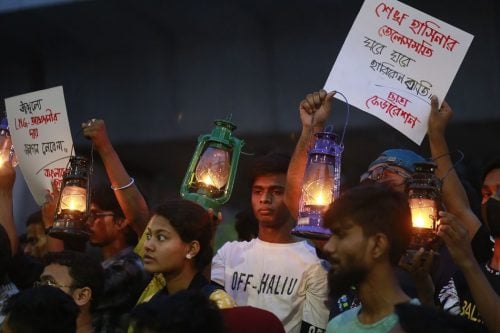Indian fuel oil is preparing to flow into the crisis-ridden neighbor Bangladesh, which suffers from its poor ability to buy more liquefied gas due to the ignition of its global prices.
And the Bangladeshi BBC announced its readiness to receive Indian fuel used in electricity generation through a pipeline linking it to India, according to the specialized platform S & P Global (s & p global).
The company has finished building the pipeline, which it has embarked on since early 2020, and is scheduled to start pumping Indian fuel oil through it in a few weeks, according to the specialized energy platform.
India surrounds Bangladesh from all geographical sides except for the far southeast of the country, as the border is with Myanmar, which is sometimes called “Burma”.
Line runtime
The pipeline is expected to start operating, starting from March 17, 2023, as part of an inauguration ceremony being arranged in the presence of Indian Prime Minister Narendra Modi and Bangladeshi Prime Minister Sheikh Hasina Wajid via remote communication technology.
The India-Bangladesh Friendship Pipeline is approximately 130 km long, 5 km of which is located in India, and the line passes through the local districts of Panchagarh, Nilphamari and Dinajpur to the Parbatipur oil storage facility in Bangladesh.
Once the cross-border pipeline is operational, Bangladesh will stop importing fuel oil from India by rail, according to the specialist energy platform.
Reduce transportation cost
The leading ready-made garment country imports around 2,200 metric tons of fuel oil from Indian companies every month, via the West Bengal Railway, and then to the Bangladesh Railway, all the way to the Parbatipur Oil Storage Facility in the north of the country.
The pipeline aims to supply the northern region of Bangladesh with its needs of fuel oil, due to the difficulty of transporting it from the main seaport located in the south of the country, known as “Chattagong” or “Chittagong”.
Indian fuel oil is to be consumed for agricultural purposes, as the demand for diesel used to operate agricultural machinery and engines is approximately 1.1 million metric tons annually.
This amount is equivalent to one-fifth of Bangladesh’s needs of liquefied gas, which the country has been facing a financial problem in importing since the middle of last year, due to the deterioration of the country’s cash reserves.
Bangladesh expects the cost of buying fuel oil from India via the new pipeline to be lower than the previous costs of transporting it via less efficient rail – as well.
Duration of the contract
The contract – concluded by the Bangladeshi company with Indian companies – provides for the purchase of Indian fuel oil on sulfur (at a rate of 0.005%), from the new pipeline for a period of 15 years, at a premium of $ 5.5 per barrel over the average Platts fuel oil in the Persian Gulf.
It is planned to transport 250,000 metric tons annually through the new pipeline, after which it will gradually increase to 400,000 metric tons during the first 5 years, and then to 500,000 tons thereafter.
The quantities transferred through the line can be modified based on the demand understandings between the two sides, and the agreement can be extended beyond 15 years, according to the contract terms that were reviewed by the specialized energy platform.
3 thousand megawatts

Bangladesh, which has a population of 165 million, relies on fuel oil to generate 3 thousand megawatts of electricity, equivalent to 35% of the domestic electricity production of 9.1 thousand megawatts.
High sulfur fuel oil is one of the oil derivatives used in electricity generation in some developing countries, especially in the summer, which witnesses huge pressures in consumption.
Bangladesh faced a crisis in foreign exchange reserves during the past year, which forced it to reduce LNG imports since the middle of last year, due to the global price escalation, and the rush of Europeans to LNG tankers destined for Asia after the Russian gas crisis.
Despite the lull in liquefied gas prices during the past two months, Bangladesh’s ability to purchase is still limited, amid additional expectations of an increase in Chinese demand, which will lead to a rise in Asian gas prices during 2023.
Gas price pressures
Energy research firm Rystad Energy expects average gas prices in Asia to rise to $32 per million British thermal units this year.
This average is much higher than the $20 price that Bangladeshi officials consider acceptable to buy gas from the spot market.
Bangladeshi companies are negotiating with companies in Papua New Guinea to secure new deals this year, according to the specialized energy platform.
Brunei Sultanate
The Prime Minister of Bangladesh, Sheikh Hasina Wajed, has been negotiating with the Sultanate of Brunei to obtain a supply deal for liquefied gas since October 19 (2022), but it has not resulted in implementation agreements so far.
In parallel, Bangladesh is looking for new markets to buy high-sulfur fuel oil, as part of plans to provide alternatives to gas used in electricity generation in a country that has a leading global industry in the field of ready-made garments.
Bangladesh’s imports of fuel oil are expected to rise to 5.5 million metric tons in 2023, up 22.2% from the previous year, according to estimates from S&P Global.
Related topics…
Also read..

Leave a Reply